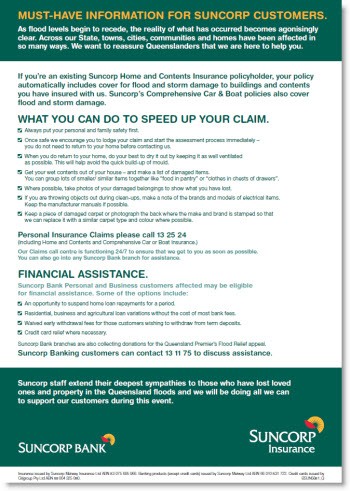Julia Gillard’s pleas for the insurance industry to offer “flexibility” to Queensland and Victorian flood victims is threatening to shine a light on some of the dubious practices of a cabal famous for its cold-heartedness.
Duopolist Suncorp, which controls over 50% of the Queensland market, is the only firm besides Zurich Financial Services that offers automatic flood coverage, as it has helpfully pointed out through a media blitz designed to remind victims just how generous it can be when your house sinks into a river.
Suncorp’s UK-born CEO Patrick Snowball paid himself $4 million last financial year (including $1 million in long-term bonuses). His company controls the GIO, AAMI, Vero and Apia brands in addition to its headline business. According to media manager Jamin Smith, the firm’s “informational” campaign has been tailored to assist victims rather than draw attention to flood-free rivals at Insurance Australia Group.
“This is very much a campaign about what families and companies can do next,” he said.
Crikey understands Snowball scrambled back from his Christmas vacation in South Africa to take the reins of the firm, possibly to avoid a repeat of Gough Whitlam’s famous no-show in the wake of Cyclone Tracy. But the relentless military-trained chief, who was hired amid fanfare 18 months ago, has been spared the direct glare of the media spotlight with an army of flacks despatched to disseminate the spin.
A full-page ad [PDF] in The Sunday Mail has been backed by this slick “Floodfacts” website, which opens with a graphic of a home getting drowned under an unforgiving torrent. Luckily, Snowball and his crack team are there to assist: “From the minute flood danger is detected, the Suncorp Insurance team swing into action,” the site reassures homeless readers who’ve presumably managed to tap into a relative’s broadband.
Inconveniently, AAMI, which Suncorp acquired in 2007 as part of the $8 billion Promina merger, doesn’t offer automatic flood insurance and has been mysteriously absent from its parent firm’s PR offensive. And while Suncorp — which more than doubled its profit to a massive $780 million last year on revenue of $15.7 billion — has been quick to make hay from its superstar status, this hasn’t always been the case.
According to one well-placed insider: “The insurance industry has traditionally never covered flood. This is because they tend to happen. Tsunamis used to be covered until they started to actually happen.”
And while Suncorp has been quick to spruik its coverage that it introduced in 2008, the reality is if too many residents in low-lying areas bought policies, profits would head south and already massive premiums would be bolstered on regular home and contents insurance. Industry insiders say the surcharge in some postcodes is so high that many prospective clients in low-lying Brisbane suburbs would have avoided policies altogether.
According to insurance brokers MGA, the annual cost of a Vero home and contents policy for a $500,000 house in the vulnerable Brisbane suburb of Moggill — that includes a flood provision — comes to around $1500. However, this could rise further in the wake of the floods and follows substantial increases in 2010.
Insurers have been quick to cry poor over the impact of flood payouts on profits, warning of further premium increases and floating the possibility of a jump in re-insurance costs of $120 million as multi-nationals react to Australia’s string of one-in-a-hundred year events. Advisers have issued the firm with earnings downgrades of around 10%.
But as former insurance manager Dennis O’Brien told trade publication Insurance News in 2009 in the wake of the that year’s devastating floods, premiums are factored into prices to ensure the company’s bottom line won’t be unduly eroded:
“We worked out that in the last 100 years 93% of all floods were insured under standard cover. Given that we’ve factored into the pricing the extra 7%, it hasn’t hurt us at all.”
And while some firms had previously made ex-gratia payments amid fevered political and media pressure following the 1998 Wollongong storms, Suncorp’s AAMI almost certainly won’t be doing that this time, with the discretional compensation bill likely to swell to around $50 million.
So while the Suncorp PR campaign continues to crank and the search for survivors continues in Grantham, a soft landing for shareholders seems all but assured.









Where did Andrew Crook dig up “Gough Whitlam’s famous no show in the wake of Cyclone Tracy?
Indeed where was Andrew Crook in 1974? I was with my father on Christmas Day that year, in London. I was working there, as was he – on an official visit. He reacted immediately to the news, flying back to Australia overnight.
reins not reigns anyway
“‘Comrade, if I’m going to put up with the f—wits in the Labor Party, I’ve got to have my trips.” A no-show when it mattered, no?
As a resident of the Illawarra, I recall the despicable behaviour of some insurers after the 1998 floods. There was great public disgust, the media and politicians got involved, and those bastards were shamed into doing the decent thing. I find it so frustrating – it rains, rivers swell, too much water, houses flood – without the damned rain nothing would happen, but the Insurers still try to squirm out of it. Should be put in the ‘stocks’ at noon, and we could throw the rotten food at them. Despicable people! Good on those who are going to act in a decent manner.
I recall Cyclone Tracy too, and don’t recall any “no show” by Gough Whitlam – or any other member of the govt for that matter. Response was instant and the rebuilding was great – many people from Darwin said so, and still do. Stick to the facts Andrew!
I am the first to admit that I know b*****-all about insurance, but surely they accumulate reserves appropriate to the risk. Thus, a 100-year catatsrophic event would be costed into premiums for all policies. Consequently everyone pays, but a smaller amount over a longer period. But you can bet that the companies will try to recover the cost in the short term.
I think the story about Gough (whom I admire) is not that he did not show, but that he returned to his overseas jaunt (Greece perhaps) once Stretton was getting the recovery under way.